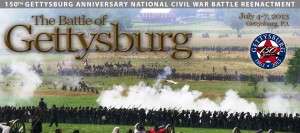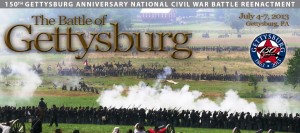East Cemetery & Culp’s Hill

“Thundering Hell – East Cemetery & Culp’s Hill
On the second day of battle, most of both armies had assembled. The Union line was laid out in a defensive formation resembling a fishhook. Lee launched a heavy assault on the Union left flank, and fierce fighting raged at Little Round Top, the Wheatfield, Devil’s Den, and the Peach Orchard. On the Union right, demonstrations escalated into full-scale assaults on Culp’s Hill and Cemetery Hill. All across the battlefield, despite significant losses, the Union defenders held their lines.
On the third day of battle, July 3, fighting resumed on Culp’s Hill, and cavalry battles raged to the east and south, but the main event was a dramatic infantry assault by 12,500 Confederates against the center of the Union line on Cemetery Ridge, known as Pickett’s Charge. The charge was repulsed by Union rifle and artillery fire, at great losses to the Confederate army. Lee led his army on a torturous retreat back to Virginia. Between 46,000 and 51,000 Americans were casualties in the three-day battle. That November, President Lincoln used the dedication ceremony for the Gettysburg National Cemetery to honor the fallen and redefine the purpose of the war in his historic Gettysburg Address.
 On July 1st, the outnumbered Federal forces that retreated from the fields west and north of town arrived on Cemetery Hill, the position chosen by Union Eleventh Corps General Oliver O. Howard as the rallying point for the Union army. General George Meade sent Major General Winfield S. Hancock to take command of the Federal forces in Gettysburg until Meade could arrive. General Hancock ordered that the Federal line be extended right to Culp’s Hill and left to Cemetery Ridge.
On July 1st, the outnumbered Federal forces that retreated from the fields west and north of town arrived on Cemetery Hill, the position chosen by Union Eleventh Corps General Oliver O. Howard as the rallying point for the Union army. General George Meade sent Major General Winfield S. Hancock to take command of the Federal forces in Gettysburg until Meade could arrive. General Hancock ordered that the Federal line be extended right to Culp’s Hill and left to Cemetery Ridge.
After pursuing the Federal forces through the town of Gettysburg on the afternoon of July 1, Ewell had extended his line from the streets of Gettysburg eastward to Rock Creek at the northeastern base of Culp’s Hill. Ewell was ordered by Lee to “press those people and secure the hill.” Due to the fact that Rodes and Early’s divisions were exhausted from fighting earlier in the day, and Johnson was not expected to arrive until nightfall, Ewell delayed in attacking Cemetery and Culp’s Hill. This would prove to be a strategic blunder.
Ewell’s demonstration against East Cemetery Hill on July 2 began at 4 p.m. at the sound of Longstreet’s guns on Seminary Ridge. The four batteries on Benner’s Hill, 1400 yards from East Cemetery Hill, were commanded by 20-year-old Major Joseph W. Latimer. The Confederates well directed fire provided deadly results to Federal forces on East Cemetery Hill for approximately three hours. But the overpowering firepower from Union positions on Cemetery and Culp’s Hill soon shattered many of Latimer’s batteries and forced the remnants to retire out of range. In the final moments of action the youthful Major Latimer was fatally wounded. The Union barrage left only one battery to cover Johnson’s infantry when the Confederate advance of Culp’s and East Cemetery Hill was ordered at 7 p.m.
The Union strength on Culp’s Hill had been diminished earlier in the day on July 2nd when Williams and Geary’s divisions were ordered to move south and help repulse Longstreet’s attack. Only Brigadier General William Greene’s brigade was left behind to defend the Union position. They scraped up loose dirt, rocks, logs and fence rails to make low breastworks. Greene’s brigade now had no troops to his right to defend the mile long hill that had been defended by 10,000 Union soldiers earlier in the day. Greene, the oldest man in either army, extended his line, and then pulled his flank back at a right angle to face it south while the rest of the line faced east.
Dusk was approaching on July 2 when the Confederates under General Johnson attacked the thin Union line. Although Union reinforcements were sent back to reinforce Greene by Wadsworth, Howard, and Hancock, the Confederates under Stuart finally drove the defenders out from many of their trenches after fierce hand to hand combat. At approximately 9:30 p.m. on the second day the fighting ceased due to darkness. Without knowing it Johnson was only two hundred yards from the Baltimore Pike – the Union right flank, the location of Union supply trains and the Union lifeline to Baltimore and Washington. This was an important Confederate misjudgment because the Federal 12th Corps was ordered back to Culp’s Hill later that night to reinforce the Union line.
At 4:30 a.m. on July 3, five Union batteries opened up a deadly fire on Johnson’s position that had been bolstered by Rodes and Early. Because of inferior positions and dense woods Johnson’s artillery could not effectively counter fire. The artillery fire ceased in approximately half an hour and the Confederates renewed their assault toward reinforced and fortified Union positions on this critical third day. Johnson’s troops attacked three times and each attack failed. For seven long hours the battle continued with tremendous carnage as Confederate forces attempted to sweep up the densely wooded hill. By counterattacking two Federal brigades finally pushed Stuart’s men out of their captured fortifications. At 11 a.m. the Confederates gave up the field after suffering terrible losses. Johnson lost 30% of his division while the Federal losses on Culp’s Hill were only 8% due to superior defensive numbers and fortifications. It is a fateful irony that Wesley Culp of the 2nd Virginia fell at a place overlooking the home where he was born.
The artillery and infantry action at Gettysburg on Culp’s and East Cemetery Hill was a critical and deadly encounter that raged for two days. Watch this action come alive with extensive pyrotechnics and the re-creation of the Evergreen Cemetery Gatehouse on Saturday, July 6th at the 150th Gettysburg Anniversary National Civil War Battle Reenactment.
http://www.gettysburgreenactment.com/reenactors/battle-scenarios/

